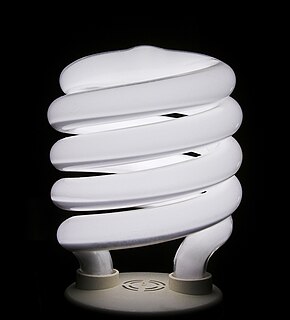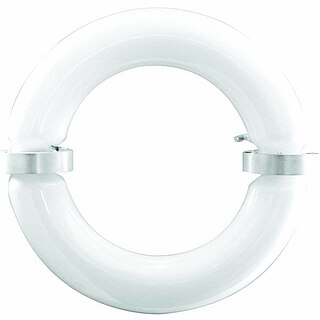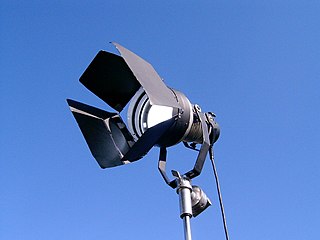
An electric light is a device that produces visible light from electric power. It is the most common form of artificial lighting and is essential to modern society, providing interior lighting for buildings and exterior light for evening and nighttime activities. In technical usage, a replaceable component that produces light from electricity is called a lamp. Lamps are commonly called light bulbs; for example, the incandescent light bulb. Lamps usually have a base made of ceramic, metal, glass, or plastic, which secures the lamp in the socket of a light fixture. The electrical connection to the socket may be made with a screw-thread base, two metal pins, two metal caps or a bayonet cap.

Artificial lighting technology began to be developed tens of thousands of years ago and continues to be refined in the present day.

A fluorescent lamp, or fluorescent tube, is a low-pressure mercury-vapor gas-discharge lamp that uses fluorescence to produce visible light. An electric current in the gas excites mercury vapor, which produces short-wave ultraviolet light that then causes a phosphor coating on the inside of the lamp to glow. A fluorescent lamp converts electrical energy into useful light much more efficiently than an incandescent lamp. The typical luminous efficacy of fluorescent lighting systems is 50–100 lumens per watt, several times the efficacy of incandescent bulbs with comparable light output. For comparison, the luminous efficacy of an incandescent bulb may only be 16 lumens per watt.
In chemistry, a halide is a binary phase, of which one part is a halogen atom and the other part is an element or radical that is less electronegative than the halogen, to make a, e.g., fluoride, chloride, or theoretically tennesside compound. The alkali metals combine directly with halogens under appropriate conditions forming halides of the general formula, MX. Many salts are halides; the hal- syllable in halide and halite reflects this correlation. All Group 1 metals form halides that are white solids at room temperature.

A gas-filled tube, also commonly known as a discharge tube or formerly as a Plücker tube, is an arrangement of electrodes in a gas within an insulating, temperature-resistant envelope. Gas-filled tubes exploit phenomena related to electric discharge in gases, and operate by ionizing the gas with an applied voltage sufficient to cause electrical conduction by the underlying phenomena of the Townsend discharge. A gas-discharge lamp is an electric light using a gas-filled tube; these include fluorescent lamps, metal-halide lamps, sodium-vapor lamps, and neon lights. Specialized gas-filled tubes such as krytrons, thyratrons, and ignitrons are used as switching devices in electric devices.

A sodium-vapor lamp is a gas-discharge lamp that uses sodium in an excited state to produce light at a characteristic wavelength near 589 nm.
Hydrargyrum quartz iodide (HQI) is a trademark name of Osram's brand of metal halide lamps made for general floodlighting, arena floodlighting, shop and commercial and industrial lighting. Hydrargyrum is the Latin name for the element mercury. When heated, mercury vapour is created inside the lamp, and deposited when it cools.

High-intensity discharge lamps are a type of electrical gas-discharge lamp which produces light by means of an electric arc between tungsten electrodes housed inside a translucent or transparent fused quartz or fused alumina arc tube. This tube is filled with noble gas and often also contains suitable metal or metal salts. The noble gas enables the arc's initial strike. Once the arc is started, it heats and evaporates the metallic admixture. Its presence in the arc plasma greatly increases the intensity of visible light produced by the arc for a given power input, as the metals have many emission spectral lines in the visible part of the spectrum. High-intensity discharge lamps are a type of arc lamp.

A mercury-vapor lamp is a gas-discharge lamp that uses an electric arc through vaporized mercury to produce light. The arc discharge is generally confined to a small fused quartz arc tube mounted within a larger borosilicate glass bulb. The outer bulb may be clear or coated with a phosphor; in either case, the outer bulb provides thermal insulation, protection from the ultraviolet radiation the light produces, and a convenient mounting for the fused quartz arc tube.
Street lighting in the United States was introduced by inventor Benjamin Franklin, who was the postmaster of Philadelphia, Pennsylvania. For this reason, many regard Philadelphia as the birthplace of street lighting in the US.

A metal-halide lamp is an electrical lamp that produces light by an electric arc through a gaseous mixture of vaporized mercury and metal halides. It is a type of high-intensity discharge (HID) gas discharge lamp. Developed in the 1960s, they are similar to mercury vapor lamps, but contain additional metal halide compounds in the quartz arc tube, which improve the efficiency and color rendition of the light. The most common metal halide compound used is sodium iodide. Once the arc tube reaches its running temperature, the sodium dissociates from the iodine, adding orange and reds to the lamp's spectrum from the sodium D line as the metal ionizes. As a result, metal-halide lamps have high luminous efficacy of around 75–100 lumens per watt, which is about twice that of mercury vapor lights and 3 to 5 times that of incandescent lights and produce an intense white light. Lamp life is 6,000 to 15,000 hours. As one of the most efficient sources of high CRI white light, metal halides as of 2005 were the fastest growing segment of the lighting industry. They are used for wide area overhead lighting of commercial, industrial, and public places, such as parking lots, sports arenas, factories, and retail stores, as well as residential security lighting and automotive headlamps.

Borosilicate glass is a type of glass with silica and boron trioxide as the main glass-forming constituents. Borosilicate glasses are known for having very low coefficients of thermal expansion, making them more resistant to thermal shock than any other common glass. Such glass is subjected to less thermal stress and can withstand temperature differentials without fracturing of about 165 °C (300 °F). It is commonly used for the construction of reagent bottles and flasks as well as lighting, electronics and cookware.

The internal electrodeless lamp, induction lamp, or electrodeless induction lamp is a gas-discharge lamp in which an electric or magnetic field transfers the power required to generate light from outside the lamp envelope to the gas inside. This is in contrast to a typical gas discharge lamp that uses internal electrodes connected to the power supply by conductors that pass through the lamp envelope. Eliminating the internal electrodes provides two advantages:

Hydrargyrum medium-arc iodide (HMI) is the trademark name of Osram's brand of metal-halide gas discharge medium arc-length lamp, made specifically for film and entertainment applications. Hydrargyrum comes from the Greek name for the element mercury.

A xenon arc lamp is a highly specialized type of gas discharge lamp, an electric light that produces light by passing electricity through ionized xenon gas at high pressure. It produces a bright white light that closely mimics natural sunlight, with applications in movie projectors in theaters, in searchlights, and for specialized uses in industry and research to simulate sunlight, often for product testing.

Gas-discharge lamps are a family of artificial light sources that generate light by sending an electric discharge through an ionized gas, a plasma.

A grow light is an electric light to help plants grow. Grow lights either attempt to provide a light spectrum similar to that of the sun, or to provide a spectrum that is more tailored to the needs of the plants being cultivated. Outdoor conditions are mimicked with varying colour, temperatures and spectral outputs from the grow light, as well as varying the intensity of the lamps. Depending on the type of plant being cultivated, the stage of cultivation, and the photoperiod required by the plants, specific ranges of spectrum, luminous efficacy and color temperature are desirable for use with specific plants and time periods.
Ceravision is a privately owned lighting company based in Milton Keynes, UK. Ceravision is the inventor of High Efficiency Plasma (HEP) lighting technology, a new and unique genre of electrodeless lamps, driven by radio frequency (RF) and particularly suited to medium and high power commercial applications.
U-HID is a type of lamp. A mixture of two physical principles in lighting electronics, U-HID is the combination of Plasma and High Intensity Discharge (HID) technologies. The U-HID lamp produces a beam of light due to the formation of a plasma discharge arc. Its tube is made of a sphere of transparent quartz or ceramic filled with a special inactive high pressure gas. Through the plasma formation in its core, the atoms outside the chamber produce light. At the beginning of the plasma formation, a blue color at the tips of the inner glass insulation can be seen. This can be considered a characteristic of the technology.














